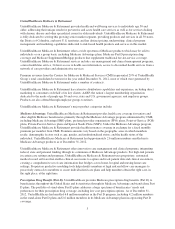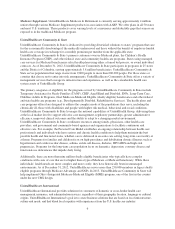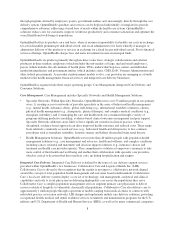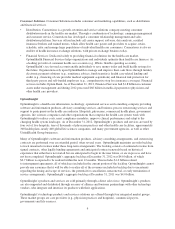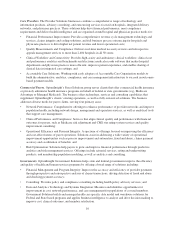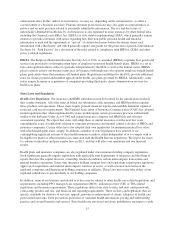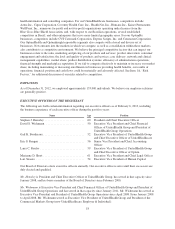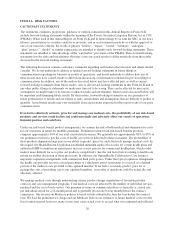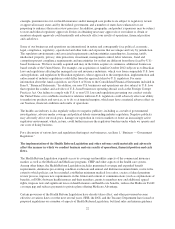United Healthcare 2012 Annual Report Download - page 17
Download and view the complete annual report
Please find page 17 of the 2012 United Healthcare annual report below. You can navigate through the pages in the report by either clicking on the pages listed below, or by using the keyword search tool below to find specific information within the annual report.enforcement rules. In the conduct of our business, we may act, depending on the circumstances, as either a
covered entity or a business associate. Federal consumer protection laws may also apply in some instances to
privacy and security practices related to personally identifiable information. The use and disclosure of
individually identifiable health data by our businesses is also regulated in some instances by other federal laws,
including the Gramm-Leach-Bliley Act (GLBA) or state statutes implementing GLBA, which generally require
insurers to provide customers with notice regarding how their non-public personal health and financial
information is used and the opportunity to “opt out” of certain disclosures before the insurer shares such
information with a third party, and which generally require safeguards for the protection of personal information.
See Item 1A, “Risk Factors” for a discussion of the risks related to compliance with HIPAA, GLBA and other
privacy-related regulations.
ERISA. The Employee Retirement Income Security Act of 1974, as amended (ERISA), regulates how goods and
services are provided to or through certain types of employer-sponsored health benefit plans. ERISA is a set of
laws and regulations that is subject to periodic interpretation by the DOL as well as the federal courts. ERISA
places controls on how our business units may do business with employers who sponsor employee benefit health
plans, particularly those that maintain self-funded plans. Regulations established by the DOL provide additional
rules for claims payment and member appeals under health care plans governed by ERISA. Additionally, some
states require licensure or registration of companies providing third-party claims administration services for
health care plans.
State Laws and Regulation
Health Care Regulation. Our insurance and HMO subsidiaries must be licensed by the jurisdictions in which
they conduct business. All of the states in which our subsidiaries offer insurance and HMO products regulate
those products and operations. These states require periodic financial reports and establish minimum capital or
restricted cash reserve requirements. The National Association of Insurance Commissioners (NAIC) has adopted
model regulations that, when implemented by states would require certain governance practices substantially
similar to the Sarbanes-Oxley Act of 2002 and expand insurance company and HMO risk and solvency
assessment reporting. We expect that states will adopt these or similar measures over the next few years,
expanding the scope of regulations relating to corporate governance and internal control activities of HMOs and
insurance companies. Certain states have also adopted their own regulations for minimum medical loss ratios
with which health plans must comply. In addition, a number of state legislatures have enacted or are
contemplating significant reforms of their health insurance markets, either independent of or to comply with or
be eligible for grants or other incentives in connection with the Health Reform Legislation. We expect the states
to continue to introduce and pass similar laws in 2013, and this will affect our operations and our financial
results.
Health plans and insurance companies are also regulated under state insurance holding company regulations.
Such regulations generally require registration with applicable state departments of insurance and the filing of
reports that describe capital structure, ownership, financial condition, certain intercompany transactions and
general business operations. Some state insurance holding company laws and regulations require prior regulatory
approval of acquisitions and material intercompany transfers of assets, as well as transactions between the
regulated companies and their parent holding companies or affiliates. These laws may restrict the ability of our
regulated subsidiaries to pay dividends to our holding companies.
In addition, some of our business and related activities may be subject to other health care-related regulations and
requirements, including PPO, managed care organization (MCO), utilization review (UR) or TPA-related
regulations and licensure requirements. These regulations differ from state to state, and may contain network,
contracting, product and rate, and financial and reporting requirements. There are laws and regulations that set
specific standards for delivery of services, appeals, grievances and payment of claims, adequacy of health care
professional networks, fraud prevention, protection of consumer health information, pricing and underwriting
practice and covered benefits and services. State health care anti-fraud and abuse prohibitions encompass a wide
15


